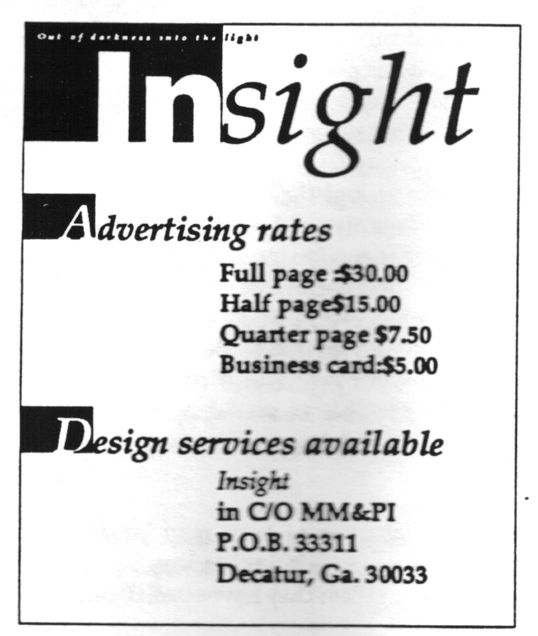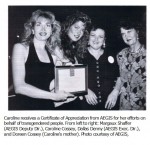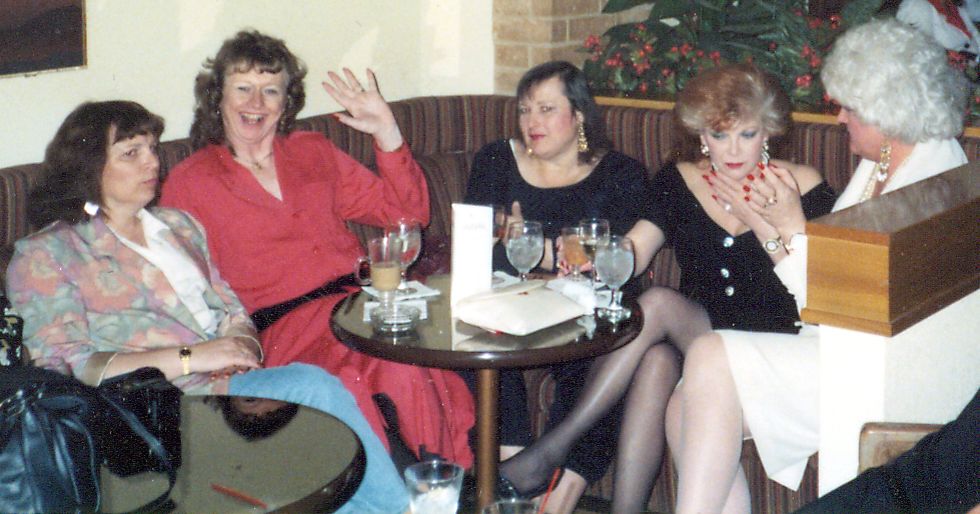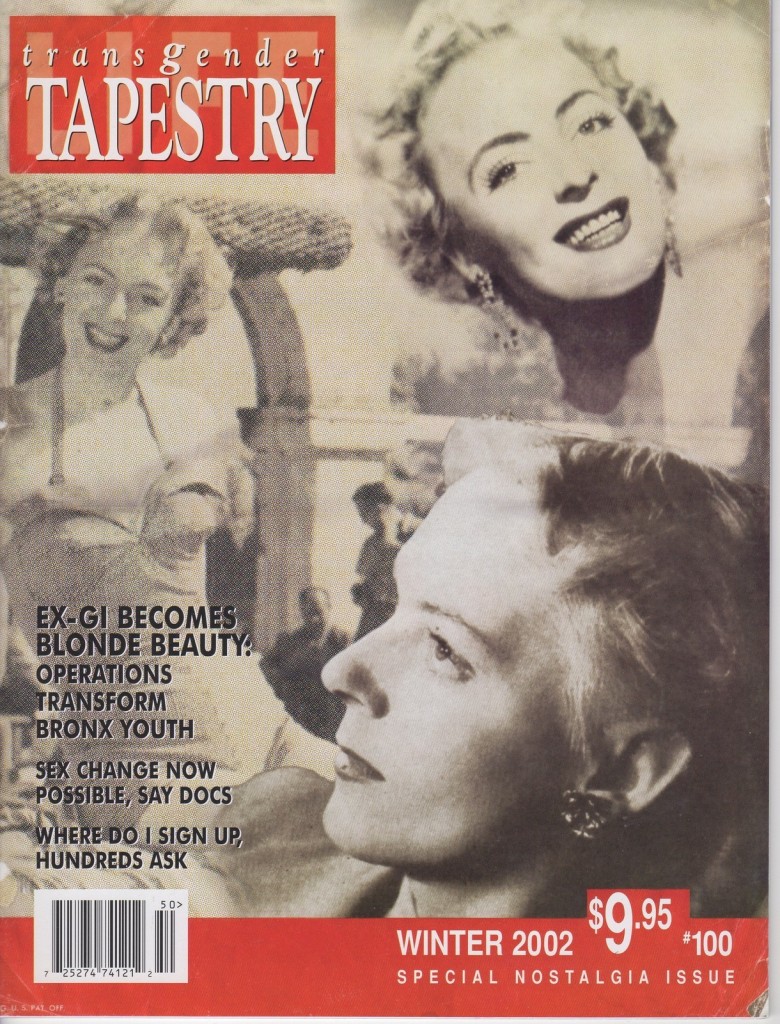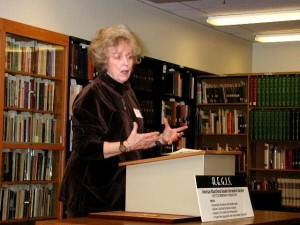Activism
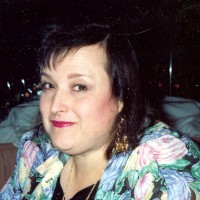
I’ve been working on behalf of transsexual and transgendered people since 1988.
I was drawn into activism because for many years I found it impossible to obtain the information I needed to help me make informed decisions about my life. After my gender transition in 1989 I found myself unable to walk away, to “get on with my life” by disappearing into society, which was what I was “supposed” to do. I got on with my life by helping others. It was never my intention to become an activist; I just couldn’t walk away from people who were in desperate need of help. That’s why I sometimes refer to myself as an accidental activist.
The following is far from a complete account of my activism. Oh, the stories I could tell! I’ve tried to limit myself to the highlights. Click the tabs to open.
Director, Montgomery Medical and Psychological Institute, 1989-1990
Despite the highfalutin’ name, MM&PI was a support group. When I contacted the group in early 1989, founders Lynn and Jerry Montgomery told me for the first time about the Standards of Care and gave me a referral to a therapist. At their support group meetings, I met other transsexuals for the first time.
In September, 1989, at Lynn and Jerry’s insistence, I became director of their program. I served for one year more or less before we parted ways over our conflicting views of transsexualism. In September, 1990 I resigned from the MM&PI support group and announced the formation of the 501(c)(3) nonprofit American Educational Gender Information Service, a clearinghouse for information about transsexualism. A few months later I founded Atlanta Gender Explorations, an open trans support group that is still around and healthy today.
Founder and Executive Director, AEGIS, 1990-1998
 AEGIS was formed in 1990 as the Atlanta Educational Gender Information Service, but it soon became apparent its mission was national in scope, and I changed the first word to American. AEGIS soon achieved IRS 501(c)(3) nonprofit status. I served as executive director from 1990-1998.
AEGIS was formed in 1990 as the Atlanta Educational Gender Information Service, but it soon became apparent its mission was national in scope, and I changed the first word to American. AEGIS soon achieved IRS 501(c)(3) nonprofit status. I served as executive director from 1990-1998.
Mission
The American Educational Gender Information Service, Inc. (AEGIS) is a 501(c)(3) nonprofit clearinghouse for transsexual and transgender issues. AEGIS actively supports the professionalization and standardization of services for transgendered persons; promotes non‑judgmental, non‑discriminatory treatment of persons with gender issues; advocate respect for their dignity, their right to treatment, and their right to choose their gender role; helps transgendered persons make reasoned and informed decisions about the ways in which they will live their lives; and provides educational materials, information, and referrals.
As difficult as it might be to believe, when AEGIS’ mission statement was written in 1989 it was past the cutting edge. No one, so far as I know, had ever specifically asked that we be treated with dignity and respect or that the services supplied us be professional and standardized or that we were entitled to choose our gender role.
By the mid-1990s the mission statement was no longer outrageous. It had become like, duh! That’s how fast, thanks to the efforts of AEGIS and other trans organizations, things were changing. We had done what few nonprofits do—realized our goal! It was time to wind the organization down or to set new goals. We chose to transform from a brick-and-mortar, paper-and-stamps nonprofit to a web-based entity and changed our name to Gender Education & Advocacy, Inc.
Heritage
AEGIS was the formal successor to J2CP, a West Coast-based information service operated in the mid-to-late 1980s by Joanna Clark (known during her years as an Episcopal nun as Sister Mary Elizabeth) and Jude Patton. Clark, who had become the moving force in another AEGIS (AIDS Education and Global Information System), formally passed the baton in 1993.
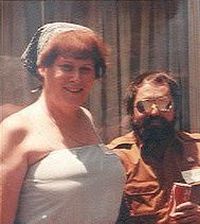
Joanna Clark and Jude Patton, 1982
Jude and Joanna had taken on the not inconsiderable responsibility of providing education about transsexualism from the late psychologist Paul Walker, who operated the Janus Information Facility. Walker, who was founding President of HBIGDA, had in turn taken over that responsibility when The Erickson Educational Foundation, which was formed in 1964, wound down its operations in the late 1970s.
Thus, AEGIS continued a nearly 3o-year-long tradition of providing services to transsexuals.
When I launched AEGIS in 1990 it was my intention to continue an exclusive focus upon transsexualism. By that time, however, there was substantive change in the air and the term transgender was gaining in popularity. I broadened the scope and used the term transgender in the mission statement because I realized people needed information, legal protections, and medical care regardless of the labels they chose to use.
AEGIS’ Services
- Membership with general, professional, student, and correctional categories and categories for our financial benefactors.
- We are a 501(c)(3) nonprofit corporation, so donations are tax deductible under IRS codes.
- Maintain a 30+ member advisory board, the members of which we consult regularly about important medical‑related and social issues.
- Provide free information about transgender and transsexual issues
- Free referrals to helping professionals and support groups via US Mail, telephone, FAX, or e‑mail.
- Publish the bi‑annual journal Chrysalis
- Publish a quarterly newsletter for members (AEGIS News)
- Produce an annual newsletter for the Transgender Historical Society (Shhh! The Newsletter of the National Transgender Library & Archive)
- A bi‑annual newsletter for helping professionals (Transgender Treatment Bulletin)
- Maintain an extensive database of helping professionals and support groups (about 2700 entries). The database is updated daily.
- Maintain an extensive bibliography of trans‑related materials (more than 6500 items), available in hardback as D. Denny (1994). Gender Dysphoria: A Guide to Research. New York: Garland Publishers. The bibliography is updated daily.
- Maintain a mail-order bookstore (60+ titles). The bookstore can also be taken to conferences.
- Maintain and grow the National Transgender Library & Archive—the largest publicly available collection of trans‑related material in the world and maybe the universe. The NTL&A contains historical material dating back to the early 1900’s, including sheet music, postcards, newsletters, magazines, journals, memorabilia, and books. The collection currently fills two rooms.
- Maintain a staffed telephone help line and an automated system that allows callers to listen to over 100 pre‑recorded messages, and will FAX‑back referral information.
- Offer affiliation to other organizations; we currently have two affiliated groups.
- Publish periodic health advisories and position papers
- Publish educational pamphlets, flyers,and booklets
- Hold free or low‑cost educational seminars about trans issues
- Write letters in support of transpersons at work and in legal battles
- Provide amicus curae briefs for selected court cases
- Provide consultation to helping professionals RE their trans clients
- Maintain an FTP site on the internet with several hundred files, including back issues of Chrysalis
- Publish AEGIS NEWS, a trans‑related newsfeed distributed bi-weekly on the internet.
- Distribute GENDER HELP, an electronic mailing list for health and transition-related issues.
Some Facts About AEGIS
- We are a founding member of GenderPAC.
- We are a founding member of Transgender Alliance for Community.
- We were a founding member of Southern Comfort.
- We provided the initial impetus and seed money for the first FTM Conference of the Americas.
- We were a sponsor of the 1st International Congress on Cross‑Dressing, Sex, and Gender Issues.
- We started the Atlanta Gender Explorations support group, which has been in operation since 1990 and which has seen hundreds of people through exploration and gender transition.
- We conduct research projects; results are routinely published in books or professional journals.
- We have made hundreds of presentations at universities, civic organizations, radio and television shows, and transgender conferences.
- We influence public policy at local, state, and national levels.
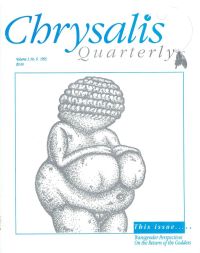 For eight years, AEGIS advocated for the rights of transsexual and transgendered people, providing free referrals and information. We (meaning me) responded with personal messages to thousands of letters from often desperate transsexuals and provided the writers with as much free material as we could stuff into a #10 envelope. When a SASE was enclosed we used it; in most cases no stamp was enclosed and we paid the postage.
For eight years, AEGIS advocated for the rights of transsexual and transgendered people, providing free referrals and information. We (meaning me) responded with personal messages to thousands of letters from often desperate transsexuals and provided the writers with as much free material as we could stuff into a #10 envelope. When a SASE was enclosed we used it; in most cases no stamp was enclosed and we paid the postage.
We (again, meaning mostly me) published a wide variety of print materials, including the acclaimed journal Chrysalis Quarterly, the newsletters AEGIS News and Transgender Treatment Bulletin, and assorted self-help booklets and pamphlets. We also operated a mail-order bookstore from which we sold back issues of our periodicals and books and magazines which we purchased for resale. We operated a 24-hour telephone help line which provided information to trans* people, their families, reporters, and helping professionals. Around 1994 we added an automated help line; while callers could still talk to a volunteer (again, mostly me), they could also listen to hundreds of recorded messages. It was rather like a telephone FAQ line, and it was heavily used until a lightning strike took the system out.

Stacks at the National Transgender Library & Archive. The collection filled two rooms at AEGIS Headquarters. It now resides at the University of Michigan Library.
From 1992 onward we maintained an on-premises trans* library that filled two rooms and was open to the public. In 1994 we named the collection The National Transgender Library & Archive and launched a newsletter dedicated to historical preservation of trans* materials. In 1994 I started what I believe to be the first internet-based news reposting service; this was eventually merged with the Gender Advocacy Internet News feed, which was maintained by Penni Ashe Matz until her death in 2001. Today’s excellent Transgender News Yahoo group is a successor of GAIN.
AEGIS was operated by a Board of Directors; chairs included Marissa Richmond and the late JoAnn Roberts. I was the unpaid Executive Director. Other unpaid staff served briefly; this included Holly Boswell (an editor for Chrysalis) and Dr. Erin Swenson (CFO). The board sought guidance from a 35-member Advisory Board which consisted of notable trans* people and helping professionals of the day.
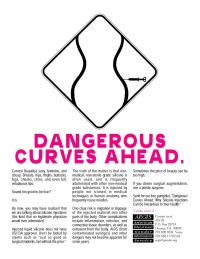 AEGIS responded in print to defamation of trans* people, writing letters to editors and issuing press releases when appropriate. From our inception we warned about the infamous surgeon John Ronald Brown, who, after he lost his license to practice medicine, performed genital reassignment surgery in nonsterile kitchens and living rooms. In 1998 Brown removed the healthy leg of 79-year-old Philip Bondy; Bondy’s body was found a few days later in a motel room. He had died of gas gangrene. San Diego prosecutor Stacey Running was unable to make heads or tails of why Brown had removed Bondy’s leg until I called and spoke with homicide detective Gary Stovall and told him about what is now called body integrity identity disorder.
AEGIS responded in print to defamation of trans* people, writing letters to editors and issuing press releases when appropriate. From our inception we warned about the infamous surgeon John Ronald Brown, who, after he lost his license to practice medicine, performed genital reassignment surgery in nonsterile kitchens and living rooms. In 1998 Brown removed the healthy leg of 79-year-old Philip Bondy; Bondy’s body was found a few days later in a motel room. He had died of gas gangrene. San Diego prosecutor Stacey Running was unable to make heads or tails of why Brown had removed Bondy’s leg until I called and spoke with homicide detective Gary Stovall and told him about what is now called body integrity identity disorder.
We also warned repeatedly about the dangers of injected silicone. I continue to speak about silicone to this day.
AEGIS worked for trans* inclusion in (then) GLB organizations, most of which didn’t yet have transpeople on their radars. We attended Pride events and wrote articles about transsexualism for local and national gay and lesbian magazines and newsletters. In 1992 I spoke to the board of the Atlanta chapter of PFLAG (which was then called Parents and Friends of Lesbians and Gays) and gave them materials to pass on to the national office, which, happily, they did. For a short time PFLAG National disseminated AEGIS’ materials, but soon developed their own brochures and booklets. They quickly changed their mission statement and eventually their name to reflect the broader scope of their activities. Since 1992, PFLAG has been a terrific source of support for transpeople and their families.
AEGIS also placed pressure upon The Harry Benjamin International Gender Dysphoria Association, asking the organization to provide empirical data to support their policies for limiting access to hormones.
When the necessity arose, AEGIS issued position papers and medical advisory bulletins and distributed public service advertisements for publication in magazines and newsletters. Our medical advisories warned, among other things, about injectable silicone, the high incidence of polycystic ovarian disease in FTMs, the dangers of overuse of human sex hormones, and the importance of regular breast self-examination in both MTF and nonoperated FTM people. Our advisory on electrolysis in the genital area for transsexual women made electrologists aware for the first time of the importance of hair removal before vaginoplasty.

However busy I might have been, I still found time to play my guitar. Here I am with Merissa Sherrill Lynn in 1991 at the Second New Woman Conference. Please forgive me the striped pants. It was the 90s.
AEGIS and the AGE support group were two of the constellation of organizations that founded the Southern Comfort Conference. Organizations throughout the Southeast were invited to the initial planning meeting, and all participated. I provided part of the startup money by pre-paying my registration. The idea for the conference, however, came from Sabrina Marcus, who approached the International Foundation for Gender Education and asked them to start a conference based in the Southeastern U.S. IFGE Executive Director said, no, but traveled with other IFGE personnel to Atlanta to provide support for the conference.
AEGIS played an essential role in the FTM Conference of the Americas; we issued a press release promising $500 to any nonprofit which would match the funds for the purposes of holding a national conference for transmen. San Francisco-based FTM International responded and we sent them a check. AEGIS was too broke to send me to the conference, but we shipped 400 copies of an FTM-themed issue of Chrysalis for distribution at the conference. The issue was edited by anthropologist Jason Cromwell.
AEGIS was a member of the Congress of Transgender Organizations and a sponsor of the first International Congresses on Cross Dressing, Gender, and Sex Issues.
Gender Education & Advocacy, 1999-Present
Relaunch as Gender Education & Advocacy
By the mid-1990s I had become convinced the advent of the internet heralded a profound change in the way the people of the world would communicate with one another. Specifically, I saw little future for small brick-and-mortar nonprofits. AEGIS’, like other existing nonprofits, placed ads wherever possible, then sent information out free of charge in response to letters and telephone calls. That couldn’t compare to a future in which everyone’s grandmother would own a computer that was capable of accessing almost infinite amounts of information almost instantly and for free.
Another nail in the nonprofits’ coffin was the rise of trans political organizations like GenderPac. Donations which had once been earmarked for purposes of education were now being used for political gain. There was just no future in national brick and mortar trans* educational nonprofits.
Over the next few years AEGIS ceased operations and began preparing for a relaunch as Gender Education & Advocacy, Inc. I envisioned GEA as an internet presence. Through a website and mailing list we would be able to reach far more people at far less cost than had been possible with printed materials.
 GEA launched in January, 2000. Its first task was to find a home for its large collection of trans-related material. We issued a request for proposals, and, after much thought and investigation, awarded our Transgender Library & Archive to the University of Michigan in Ann Arbor. The collection arrived in Michigan that spring and, a scant two years later, had been catalogued. Today researchers and other visitors from all over the globe come, and dissertations have been written about the content.
GEA launched in January, 2000. Its first task was to find a home for its large collection of trans-related material. We issued a request for proposals, and, after much thought and investigation, awarded our Transgender Library & Archive to the University of Michigan in Ann Arbor. The collection arrived in Michigan that spring and, a scant two years later, had been catalogued. Today researchers and other visitors from all over the globe come, and dissertations have been written about the content.
Following the death of board member and GAIN project manager Penni Ashe Matz and the departure of board member and webmistress Gwen Smith, GEA became for the most part inactive. Through development of this, my personal website, I now feel confident I have learned enough to update the website and resume regular postings at gender.org.
Fantasia Fair, 1992-Present
Fantasia Fair is the longest-running trans event in North America, and arguably in the world. Every October transpeople of all sorts gather in a tiny fishing and resort village on the very tip of Cape Cod. Provincetown is perhaps best known as a gay- and lesbian- friendly town, but the Fair is its longest-running event, so it’s certainly a T*-friendly town also. The first Fantasia Fair was held in 1974.
Unlike most events, FanFair isn’t limited to a single hotel. Attendees stay in dozens of small inns, bed and breakfasts, condos, and hours. Workshops, banquets, and evening events are scattered throughout the town. And unlike other events, Fantasia Fair is a full week long.
For the Fair’s first 25 years it was sponsored by the nonprofit Outreach Institute for Gender Studies. It’s now sponsored by the 501(c)(4) nonprofit Real Life Experiences.
When, in 1992, Alison Laing called to ask if I would join Outreach’s board of directors, I was hesitant. I was aware of the rumors about financial misdeeds and not eager to become emboiled in drama and questionable behavior. When Alison told me of her own concerns I agreed on the condition we work together to bring the Fair under responsible fiscal management.
I worked hard for more than ten years to make Fantasia Fair financially accountable. I can now say that throughout the twenty-first century Fantasia Fair has been entirely accountable in its use of funds. Prices are low, the Fair’s reputation in Provincetown is now sterling, and revenues which exceed expenses are used to fund Fair scholarships and donations to Provincetown’s charities.
For most of the years since 1992 I have served as a member of the boards of Outreach and then Real Life Experiences, a member of the board or planning committee, or both, sometimes simultaneously. I was at various times publisher, director of programs, office manager, secretary of the board, and registrar. I was director from 2001 through 2007.
When I first began going to the Fair it was known as an event for well-to-do crossdressers, and deservedly so. That’s no longer the case. About half of the attendees are transsexually inclined (both MTF and FTM), and quite a few are post-op. The remainder consists of crossdressers and trans-identified individuals, genderqueer and gender nonconforming people,allies, supportive professionals, and significant others and family members. The keynotes and workshops reflect this diversity.
I give one or more presentations every year at Fantasia Fair and have twice been invited to give keynotes. In 1995 I was given the Outreach Award, in 2004 I was Ms. Fantasia Fair, and in 2008 I received Real Life Experience’s Transgender Pioneer Award.
Fantasia Fair holds a special place in my heart. I love the chilly October evenings, the smells of the sea, the seafood, the funky New England architecture, and the always ridiculous and ever sublime Follies talent show, but most of all I love to be with dear friends in a casual atmosphere that gives us plenty of time to socialize.
I’m happy to be part of the team that makes Fantasia Fair happen.
Southern Comfort, 1991-Present
The AEGIS tab, above, describes my small role in the formation of Southern Comfort, an annual conference held in Atlanta since 1992. I was a member of the board for the first conference and served intermittently on the board throughout the 1990s. I was in charge of programs for three or four years. I’ve attended every SCC but one, and presented almost every time I’ve attended. In 1999 I was invited to give a luncheon keynote. In 1997, 1998, and 1999 I worked with other mental health professionals to plan and conduct intensive workshops at SCC for helping professionals.
My involvement with SCC in this century has been limited to presenting.
Transgender Health & Education Alliance
When, in September 2014, the board of directors of Southern Comfort announced the conference was moving to Fort Lauderdale, concerned activists met to form a new organization to ensure transpeople would continue to have a home in Atlanta. I was in the room.
Before the meeting adjourned we had formed the nonprofit Transgender Health & Education Alliance. In the spring of 2015 we had our first conference, a small one for trans children and their families. In October we held the first Peach State Conference, which had 180 attendees. Both conferences are now annual events. I am a founding board member.
Editor, Transgender Tapestry Journal, 1998-2006
For eight years I was editor-in-chief of Transgender Tapestry Journal, the house publication of the International Foundation for Gender Education. Tapestry was the premiere print magazine for the trans community, and I liked the job. It was the only position I’ve held in the trans community for which I was paid. In other instances I’ve paid in one way or another for the privilege of being an activist.
I like to think 1998 through 2006 were Tapestry’s best years, but I’ll admit to bias in that regard.
Work with Other Organizations
I have played minor roles in a number of other trans* organizations. Throughout the 1990s I was the AEGIS representative to the The World Congress of Transgender Organizations. I was a founder of the political action group GenderPAC and was vice-president until, three years in, Executive Director Rikki Anne Wilchins fired the board and subverted the organization’s purpose. I was editor for a year of Rites of Passage, the quarterly newsletter of the New Woman’s Conference. I was a member of the board of the hugely attended Atlanta Pride from 1994 until 1996 and senior advisor to Atlanta Mayor Bill Campbell on GLBT affairs from 1996 until 1998. I was, at the invitation of Fran Springfield, vice-president of England’s Gender Dysphoria Trust International from 1993 until 1996 and acquisitions editor for Bill Sears’ Empathy magazine from 1993 until 1994. I was a member of the board of the Atlanta Gender Explorations support group throughout the 1990s and served as moderator for about a year. I served as advisor for Version 5 of the HBIGDA Standards of Care, which were published in 1998. In 1994 I laid out the program book for the annual meeting of the Society for the Scientific Study of Sexuality, Eastern Region’s annual conference.
Research
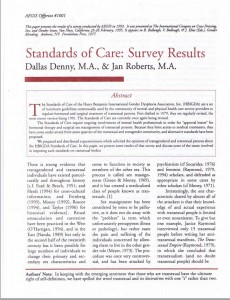 While I was at AEGIS I initiated several research projects. The first was a large-scale study (large for trans research, that is; there were 339 respondents) of attitudes of transsexual and other transgendered people toward the HBIGDA Standards of Care. My collaborator was Jan Roberts. We presented the results in Los Angeles at the First International Congress on Crossdressing, Sex, and Gender Issues in 1995. AEGIS published the resulting paper as an offprint, and it appeared as a chapter in the book Gender Blending (Bonnie Bullough, Vern Bullough, & James Elias, Eds., Prometheus Books, 1997.) Our analysis showed transsexuals and other transgendered people supported the SOC in general.
While I was at AEGIS I initiated several research projects. The first was a large-scale study (large for trans research, that is; there were 339 respondents) of attitudes of transsexual and other transgendered people toward the HBIGDA Standards of Care. My collaborator was Jan Roberts. We presented the results in Los Angeles at the First International Congress on Crossdressing, Sex, and Gender Issues in 1995. AEGIS published the resulting paper as an offprint, and it appeared as a chapter in the book Gender Blending (Bonnie Bullough, Vern Bullough, & James Elias, Eds., Prometheus Books, 1997.) Our analysis showed transsexuals and other transgendered people supported the SOC in general.
In 1997 I presented the results of a qualitative outcome study of five individuals who identified as transsexual in Philadelphia at the Second International Congress on Crossdressing, Sex, and Gender Issues. Later in 1997 I presented additional results at the Biannual Symposium of the Harry Benjamin International Gender Dysphoria Association in Vancouver. My results showed a wide variety of personal styles and strategies used in transition, in most cases successfully.
In 1998, with collaborators Jamison Green and Jason Cromwell, I initiated a study of descriptive terminology. We presented transgendered and transsexual people with a wide variety of terms and asked them to rank the terms in order of preference. We presented the results of 137 completed questionnaires at the 2001 meeting of HBIGDA in Galveston. We included information from focus groups we conducted at the 2001 Southern Comfort and Fantasia Fair conferences.
Ten years later we again surveyed the trans community about terminology preferences and dislikes. This time we received 2651 completed questionnaires. We presented our results at the 2011 WPATH symposium in Atlanta.
Our presentation at Galveston energized the conference and led to self-initiated changes in use of terminology by many of the helping professionals and researchers who attended the session.
Speaking
I have attended well more than 100 trans-related events and have spoken at almost every one of them. The tally doesn’t include the hundreds of support groups meetings to which I went or assorted small affairs.
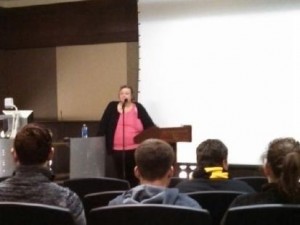
Here I’m speaking at the University of Missour, November, 2013
I’ve given invited talks at The Moving Trans* History Forward Symposium, The University of Missouri at Columbia, the Southern Comfort, Peach State Conference, Fantasia Fair, Transgender Lives Conference, and TransEvent Empire conferences, Atlanta Black Gay Pride, Atlanta Pride, banquets held by transgender organizations in Washington D.C., Nashville, and Charlotte, NC, the Outgiving Conference in Aspen CO (my thanks for Jessica Xavier for setting that one up for me), the New England Transgender Health Conference, the LGBT Community Center’s Health Conference in New York, the National Gay & Lesbian Health Association’s annual conference, a regional meeting of the Metropolitan Community Church, the 1997 HBIGDA conference in Vancouver, and at two receptions held in my honor at the University of Michigan.
I’ve made hundreds of presentations at dozens of conferences and have spoken to dozens of college and university classes (I’ve been giving presentations to Sally Lehr’s nursing classes at Emory University for some 25 years now!) I’ve given interviews to hundreds to reporters and journalists. This has led to my name appearing worldwide in Associated Press articles and in surprisingly serious articles in Playboy and Esquire magazines. I’ve appeared on Atlanta television perhaps ten times and on radio dozens of times. Far too many times my conversations with the press have come about because of tragedy—usually a transperson somewhere winding up dead.
I can and do speak on just about anything that is trans-related: managing identity documents, the dangers of silicone injection, problems with the medical model of transsexualism, managing the stress of transition, the results of my research projects, you name it.
Writing and Editing
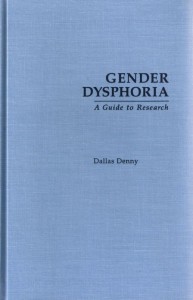 I’m a prolific writer. I’ve produced three books, more than twenty book chapters, hundreds of articles and columns for newsletters and magazines, and thousands of blog posts. I’ve written liner notes for a production of Kate Bornstein’s play Hidden: A Gender, blurbs for the back jackets of more than a dozen books, and several dozen book reviews. As editor-in-chief of Chrysalis Quarterly and then Transgender Tapestry I wrote dozens of editorials and perhaps a dozen obituaries. I’ve written monthly columns for the web-based TG Forum and editorial pages for dozens of magazine issues. I’ve written thousands of blog posts, as many as a hundred letters to assorted editors, and sent letters to thousands of transpeople who have written to me for help.
I’m a prolific writer. I’ve produced three books, more than twenty book chapters, hundreds of articles and columns for newsletters and magazines, and thousands of blog posts. I’ve written liner notes for a production of Kate Bornstein’s play Hidden: A Gender, blurbs for the back jackets of more than a dozen books, and several dozen book reviews. As editor-in-chief of Chrysalis Quarterly and then Transgender Tapestry I wrote dozens of editorials and perhaps a dozen obituaries. I’ve written monthly columns for the web-based TG Forum and editorial pages for dozens of magazine issues. I’ve written thousands of blog posts, as many as a hundred letters to assorted editors, and sent letters to thousands of transpeople who have written to me for help.
As if that weren’t enough, I write fiction, poetry, plays, and songs.
The entirety of my written work can be accessed through the blog portal and the Body of Work portions of this website.
Historical Preservation
I was one of the first to lobby for the preservation of transgender historical material.
I’ve written and spoken about the extreme difficulty of finding information about transsexualism when I was growing up and even as a young adult. Material was scarce, and what little there was was scary—sensationalistic or depicting transsexuals as maniacal killers. It’s hardly surprising that when material became available to me I collected it avidly.
In 1988 owned two books about transsexualism—a good one and a bad one. By 1992 two rooms of my home were filled with trans-related material and I was compiling a comprehensive bibliography of what I found (it was published by Garland in 1984 with the title Gender Dysphoria; A Guide to Research. It contained thousands of references to books, journal and magazine articles, and other trans-related material.
In 1994 I donated my private collection to AEGIS, the nonprofit I had formed, and announced the formation of the National Transgender Library & Archive and the Transgender Historical Society.
In 2000 the NTL&A was awarded to the Labadie Collection at the University of Michigan. This was a difficult decision, but a necessary one, as AEGIS had reinvented itself as Gender Education & Advocacy. GEA focused on electronic distribution of information; it had no space for the library. When Labadie curator Julie Harrada drove the collection to Michigan it filled the largest size U-Haul truck.
Two years later the entire collection had been archived and was available to the public. Scholars from all around the world visit to see materials I donated. What a trip!
In 2013 and 2014 I coordinated a donation of historical materials from the trans conference Fantasia Fair to the Transgender Archives at the University of Victoria. This included 585 transgender fiction titles, a genre that has to date garnered little appreciation or interest from scholars. Paradoxically, it’s a genre in which I have no personal interest, but I understand its importance.
In the fall of 2015 I received twentysome boxes of historical material from the personal collection of transgender activist Alison Laing. I have catalogued the contents of the boxes and am working with archives around the country which will digitize and scan them.
In 2014 I was a keynote speaker at Moving Trans* History Forward, the first transgender historical conference.
I continue to be concerned about preservation of trans historical material and write and speak on the subject with some regularity.
There’s little I haven’t done as a activist. I’ve served as general and foot soldier, as writer, speaker, envelope-licker, liaison to organizations, researcher, and telephone operator, as peacemaker and as agent-provocateur, as strategist and as envoy, as peacemaker and as rabble-rouser, and I’ve enjoyed almost every minute of it.
So there you have it! I’ve been a busy chickadee, haven’t I?

